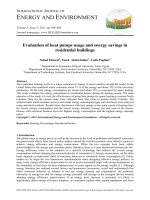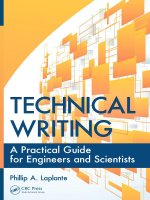Technical writing and presentation physical Infrastructure for Smart Building Applications towards Human Comfort and Energy Savings ĐH Bách Khoa Hà Nội.
Bạn đang xem bản rút gọn của tài liệu. Xem và tải ngay bản đầy đủ của tài liệu tại đây (1.24 MB, 19 trang )
Cyber
–
physical
Infrastructure
for
Smart
Building
Applications
towards
Human
Comfort
Group X
and
N V A Energy
20xxxxxx Savings
1
Table of contents
I. Structure of a paper
II. Content
III. Conclusion
2
I. Structure of a paper
1.
2.
3.
4.
5.
6.
7.
8.
9.
Title
Abstract and Keywords
Introduction
Background
System Description
Data Analysis and Discussion
Conclusion
Acknowledgement
References
3
II. Content
1.Introduction
Rapid
development
of
information
technologies facilitates modern buildings to
be smarter.
Cyber-physical systems are the key
enablers for these objectives.
They
include
various
sensors
and
actuators,edge computing devices, humanmachine interface, data analysis services to
assist building operators in monitoring and
decision-making.
It is capable of acquiring environmental
conditions of the occupants, their personal
energy consumption, human interaction
with thesystem, etc,…
4
II. Content
2. System Description
Hardware Platforms
5
II. Content
2. System Description
Software Development and System Deployment
A few software packages have been developed for each level of the system.
The software system consists of modules at different levels: sensor and
actuator node, base station or gateway and control central server.
6
II. Content
2. System Description
Software Development and System Deployment
At the base stationor gateway level, a Java application is developed and
executed in order to communicate with all the sensor and actuator nodes in
the same network.
The base station application is capable of storing all the data collected from
the nodes locally, performingsome sort of data preprocessing, decision making
regarding the control action as well as communicating with a central server of
the buildings.
7
II. Content
2. System Description
Software Development and System
Deployment
At the control central, a multi-threading
application is run to deal with data stream
from different base stations.
Each thread collects the data, process it and
fetch into MySQL database.
Besides, there are separate threads which
analyse data further and make decision on
the control action if necessary, as in the
case of the personal fan control.
8
II. Content
2. System Description
Software Development and System
Deployment
Schema for each type of sensor networks
includes SensingValues table storing the
values acquired by the respected sensors
and metadata tables
Besides, a snapshot of all the latest values
acquired by each sensor is stored in
LatestValues table
he metadata relates to sensor information,
i.e., sensor identification number (ID), name
of the sensor, model number, engineering
unit.
9
II. Content
2. System Description
Software Development
Deployment
and
System
10
II. Content
3.
Data
Discussion
Analysis
Data
collection
considerations
and
and
other
11
II. Content
3. Data Analysis and Discussion
Energy consumption with respect to outdoor-indoor temperature
difference
12
II. Content
3. Data Analysis and Discussion
Energy consumption with respect to outdoor-indoor temperature
difference
13
II. Content
3. Data Analysis and Discussion
Energy consumption with respect to outdoor-indoor temperature
difference
14
II. Content
3. Data Analysis and Discussion
Energy consumption with respect to outdoor-indoor temperature
difference
15
II. Content
3. Data Analysis and Discussion
Energy consumption with respect to outdoor-indoor temperature
difference
16
II. Content
4. Conclusion and Acknowledgement
In this work, a cyber-physical system for smart building has been presented
Data collection and analysis of energy usage for the air conditioning system
are performed..
The data are correlated with the indoor and outdoor environmental conditions.
Acknowledgement: “This work is funded by the Hanoi University of Science
and Technology (HUST) under project number T2018-TT-208. It is also
supported by Electrical Machines and Drives Labortory, National University of
Singapore”
17
III. Conclusion
Learn the structure of an article and how to read and filter its
information.
Important factors, should be enough for a complete article.
18
THANK YOU
!









